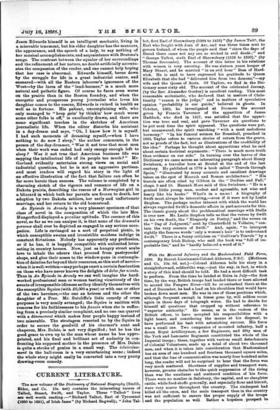CURRENT LITERATURE.
The new volume of the Dictionary of National Biography (Smith, Elder, and Co. 15s. net) contains the interesting names of Talbot, Stuart, Swift, and Taylor. Three "Talbot" lives are well worth reading :—"Richard Talbot, Earl of Tyrconnel (1630 to 1691), of Irish fame" (by Richard Bagwell); " John Tal- bot, first Earl of Shrewsbury (1388 to 1453) " (by James Tait", the Earl who fought with Joan of Arc, and was three times sent to govern Ireland, of whom the people said that "since the days of Herod there came not any one so wicked in evil deeds ; " and " George Talbot, sixth Earl of Shrewsbury (1528 to 1590)," (by Thomas Seccombe). The account of this latter in his relations with women is very amusing. He was sixteen years keeper of Mary Stuart, and he married " in an evil hour" Bess of Hard- wick. He is said to have expressed his gratitude to Queen Elizabeth that she had "delivered him from two demons,"—my wife and the Queen of Scots. Of Taylors, we find in the Dic- tionary some sixty odd. The account of the celebrated Jeremy, (by the Rev. Alexander Gordon) is excellent reading. This most reasonable ecclesiastic, who declared that in matters of Chris- tianity " reason is the judge," and in matters of speculative opinion "probability is our guide," believed in ghosts. In October, 1662, he investigated at Dromore the account given by Francis Taverner of the apparition of James Haddock, who died in 1567, was satisfied that the appari- tion was true and real, and gave Taverner six questions to be put next time the spirit appeared. The questions were put, but unanswered, the spirit vanishing " with a most melodious harmony." "In his funeral sermon for Bramhall, preached in 1663, Taylor refers to various stories of return from the grave, not as proofs of the fact, but as illustrations of the credibility of the idea." Perhaps he thought about apparitions what he said about certain doctrinal arguments : " There is much more truth than evidence on our side." In turning over the leaves of the Dictionary we came across an interesting paragraph about Henry Swinburn, a traveller born at Bristol at the end of the last century. He published in 1779 a book called " Travels through Spain," " illustrated by many accurate and excellent drawings taken on the spot of Moorish and Roman architecture." " His travels are often cited by Gibbon in the " Decline and Fall," chaps. 9 and 10. Hannah More said of this Swinburn " He is a genteel little young man, modest and agreeable, not wise and heavy like his books." What's in a name ! A biography of Swift must always be interesting,—even if it were not by Leslie Stephen. The perhaps undue interest with which the world has always regarded Swift's domestic affairs in part accounts for this. The classic gossip &mad the problematical marriage with Stella is ever new Mr. Leslie Stephen tells us that the verses by Swift on his own death, the " Rhapsody on Poetry," and the verses on the " Day of Judgment," sent by Chesterfield to Voltaire, " con- tain the very essence of Swift." And, again, "to interpret rightly the famous words `only a woman's hair' is to understand Swift." There is a funny criticism on " Gulliver's Travels " by a contemporary Irish Bishop, who said the book was " full of im- probable lies," and he " hardly belie ied a word of it."


































 Previous page
Previous page